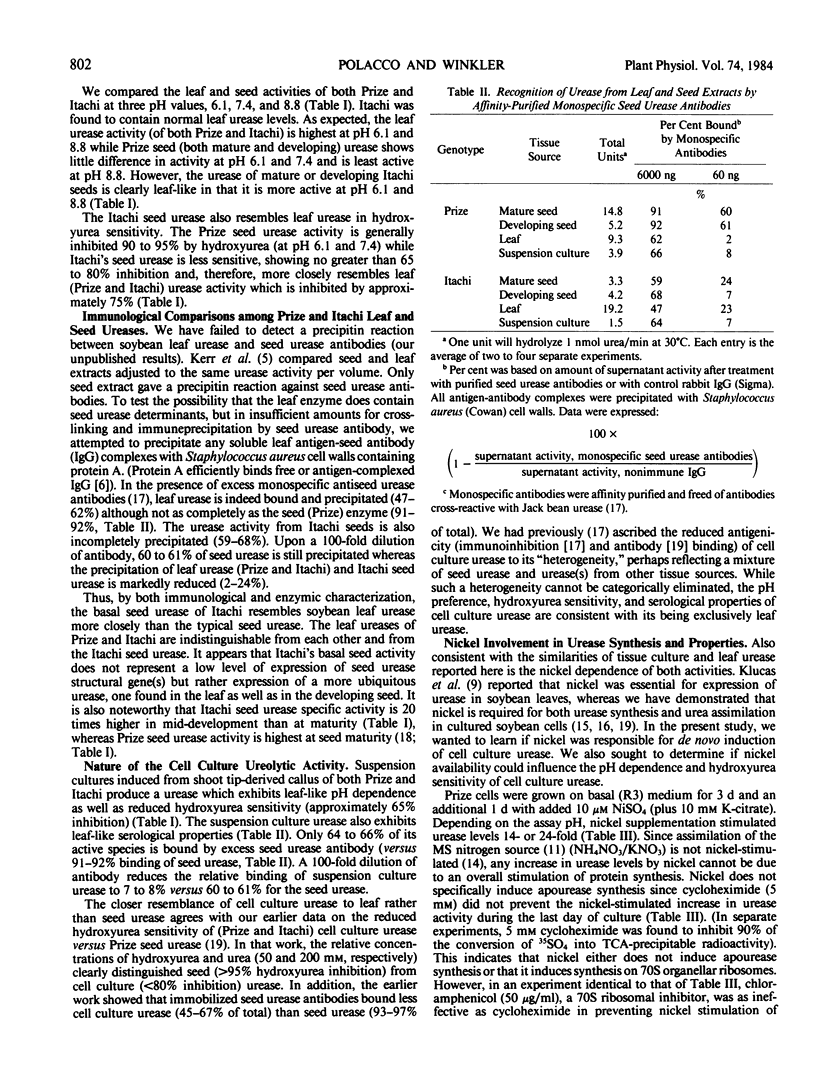Abstract
The soybean (Glycine max L. [Merrill]) var Itachi has 0.2 to 0.3% the urease activity found in developing embryos of a normal line, Prize. The hydroxyurea sensitivity and pH preference of this basal seed urease indicate that it represents a unique enzyme rather than an unusually low level of the normal seed urease. Itachi's seed urease is less sensitive to hydroxyurea inhibition (65-80% inhibition) than Prize seed urease (85-95% inhibition) and is more active at pH 6.1 and 8.8 than at 7.4, whereas the normal seed urease is least active at pH 8.8. Both properties of the basal seed urease are in agreement with the behavior of the leaf urease in extracts of Prize and Itachi leaves.
Neither the leaf urease nor the Itachi seed urease is immuneprecipitated by affinity-purified seed urease antibodies. However, when antibody is in excess, Staphylococcus aureus (Cowan) cell walls containing protein A can precipitate soluble antibody-urease complexes (47-68% of total enzyme) from both leaf (Itachi and Prize) and Itachi seed extracts. Under identical conditions, greater than 90% of Prize seed urease is precipitated. At a 100-fold dilution of antibody, 60% of Prize seed urease is still antibody-complexed while the antibody recognition of the leaf or Itachi seed urease is reduced to 2 to 24%.
The cell culture urease also resembles leaf urease by the criteria of pH preference, hydroxyurea sensitivity, and recognition by seed urease antibodies. In the presence of cycloheximide, nickel stimulates cell culture urease levels (14- or 35-fold depending on assay pH) indicating that cell cultures make a preponderance of apourease under nickel-limiting conditions.
Inasmuch as the ureases of leaf, cell culture, and Itachi seeds are more closely related to each other than they are to the abundant (Prize) seed urease, suggests that the three tissues either contain an identical urease or related tissue-specific isozymes. This second form of urease may have an assimilatory role since it is found in both leaf and seed sink tissues and is required for urea assimilation in cell culture (Polacco 1977 Plant Physiol 59: 827-830).
Full text
PDF



Selected References
These references are in PubMed. This may not be the complete list of references from this article.
- Goldberg R. B., Hoschek G., Vodkin L. O. An insertion sequence blocks the expression of a soybean lectin gene. Cell. 1983 Jun;33(2):465–475. doi: 10.1016/0092-8674(83)90428-2. [DOI] [PubMed] [Google Scholar]
- Kessler S. W. Rapid isolation of antigens from cells with a staphylococcal protein A-antibody adsorbent: parameters of the interaction of antibody-antigen complexes with protein A. J Immunol. 1975 Dec;115(6):1617–1624. [PubMed] [Google Scholar]
- Klucas R. V., Hanus F. J., Russell S. A., Evans H. J. Nickel: A micronutrient element for hydrogen-dependent growth of Rhizobium japonicum and for expression of urease activity in soybean leaves. Proc Natl Acad Sci U S A. 1983 Apr;80(8):2253–2257. doi: 10.1073/pnas.80.8.2253. [DOI] [PMC free article] [PubMed] [Google Scholar]
- MCGILVERY R. W., MOKRASCH L. C. Purification and properties of fructose-1, 6-diphosphatase. J Biol Chem. 1956 Aug;221(2):909–917. [PubMed] [Google Scholar]
- Polacco J. C., Havir E. A. Comparisons of soybean urease isolated from seed and tissue culture. J Biol Chem. 1979 Mar 10;254(5):1707–1715. [PubMed] [Google Scholar]
- Polacco J. C. Nitrogen Metabolism in Soybean Tissue Culture: II. Urea Utilization and Urease Synthesis Require Ni. Plant Physiol. 1977 May;59(5):827–830. doi: 10.1104/pp.59.5.827. [DOI] [PMC free article] [PubMed] [Google Scholar]
- Polacco J. C. Nitrogen metabolism in soybean tissue culture: I. Assimilation of urea. Plant Physiol. 1976 Sep;58(3):350–357. doi: 10.1104/pp.58.3.350. [DOI] [PMC free article] [PubMed] [Google Scholar]
- Polacco J. C., Sparks R. B. Patterns of urease synthesis in developing soybeans. Plant Physiol. 1982 Jul;70(1):189–194. doi: 10.1104/pp.70.1.189. [DOI] [PMC free article] [PubMed] [Google Scholar]
- Polacco J. C., Thomas A. L., Bledsoe P. J. A soybean seed urease-null produces urease in cell culture. Plant Physiol. 1982 May;69(5):1233–1240. doi: 10.1104/pp.69.5.1233. [DOI] [PMC free article] [PubMed] [Google Scholar]
- Pull S. P., Pueppke S. G., Hymowitz T., Orf J. H. Soybean lines lacking the 120,000-dalton seed lectin. Science. 1978 Jun 16;200(4347):1277–1279. doi: 10.1126/science.200.4347.1277. [DOI] [PubMed] [Google Scholar]
- Staswick P. E., Nielsen N. C. Characterization of a soybean cultivar lacking certain glycinin subunits. Arch Biochem Biophys. 1983 May;223(1):1–8. doi: 10.1016/0003-9861(83)90565-9. [DOI] [PubMed] [Google Scholar]
- Winkler R. G., Polacco J. C., Eskew D. L., Welch R. M. Nickel is not required for apourease synthesis in soybean seeds. Plant Physiol. 1983 May;72(1):262–263. doi: 10.1104/pp.72.1.262. [DOI] [PMC free article] [PubMed] [Google Scholar]


